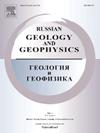Experimental Modeling of the Interaction between Garnets of Mantle Parageneses and CO2 Fluid at 6.3 GPa and 950–1550 °C
IF 1
4区 地球科学
Q3 GEOSCIENCES, MULTIDISCIPLINARY
引用次数: 2
Abstract
—Experimental modeling of the interaction of eclogitic and lherzolitic garnets with CO2 fluid was carried out on a multianvil high-pressure apparatus of the “split-sphere” type (BARS) in platinum ampoules with inner graphite capsules, using a buffered high-pressure cell with a hematite container, at a pressure of 6.3 GPa and in the temperature range 950–1550 °C. It has been established that the main interaction processes at 6.3 GPa and 950–1250 °C are partial dissolution, recrystallization, and carbonation of garnet which lead to the formation of magnesian carbonate, kyanite, and coesite, a decrease in Mg contents in the recrystallized garnet, and the formation of carbonate, silicate, and oxide inclusions in it. Under these conditions, crystallization of metastable graphite and growth of diamond on the seed at ≥1250 °C were observed. In the temperature range 1350–1550 °C, the garnet underwent partial dissolution and recrystallization in CO2 fluid; no carbonation took place. These processes were accompanied by a decrease in the portion of the grossular component in the garnet and by the enrichment of the fluid phase with calcium. We have established the indicative characteristics of garnet that interacted with CO2 fluid: zoning, with low contents of CaO and MgO in the rims of crystals relative to the cores, and the presence of carbonate, kyanite, coesite, and CO2 inclusions. The compositions of the produced garnet and carbonates are consistent with the data on these minerals in mantle peridotite and eclogite parageneses and in inclusions in diamonds, which suggests a significant role of metasomatism with the participation of CO2 fluid in the evolution of deep-seated rocks and in the diamond formation. In this experimental research, we have first studied the processes of diamond crystallization and determined the boundary conditions for diamond growth in the system silicate–carbonate–CO2, which simulates natural diamond formation media. In general, the established regularities can be regarded as potential indicators of mantle metasomatism and mineral formation with the participation of CO2 fluid.6.3 GPa、950 ~ 1550℃条件下地幔共生石榴石与CO2流体相互作用的实验模拟
在一个“分裂球”式(BARS)的多砧高压装置上,利用一个带赤铁矿容器的缓冲高压电池,在压力为6.3 GPa、温度范围为950-1550℃的条件下,对含石墨胶囊的铂安瓿进行了榴辉石和橄榄石石榴石与二氧化碳流体的相互作用进行了实验模拟。结果表明:在6.3 GPa和950 ~ 1250℃下,石榴石的部分溶解、再结晶和碳酸化是主要的相互作用过程,形成镁质碳酸盐、蓝晶石和钴矿,再结晶石榴石中Mg含量降低,形成碳酸盐、硅酸盐和氧化物包裹体。在此条件下,亚稳石墨在≥1250℃时结晶,金刚石在种子上生长。在1350 ~ 1550℃的温度范围内,石榴石在CO2流体中发生部分溶解和再结晶;没有发生碳酸化。这些过程伴随着石榴石中粗晶成分的减少和流体相中钙的富集。我们确定了石榴石与CO2流体相互作用的指示性特征:分带,晶体边缘相对于岩心具有低含量的CaO和MgO,并且存在碳酸盐、蓝晶石、钴矿和CO2包裹体。所产石榴石和碳酸盐的组成与地幔橄榄岩和榴辉岩副长岩以及钻石包裹体中这些矿物的数据一致,表明在深部岩石演化和钻石形成过程中,有CO2流体参与的交代作用。在本实验研究中,我们首先研究了金刚石的结晶过程,确定了在模拟天然金刚石形成介质硅酸盐-碳酸盐- co2体系中金刚石生长的边界条件。总的来说,所建立的规律可以作为地幔交代和CO2流体参与的矿物形成的潜在指标。
本文章由计算机程序翻译,如有差异,请以英文原文为准。
求助全文
约1分钟内获得全文
求助全文
来源期刊

Russian Geology and Geophysics
地学-地球科学综合
CiteScore
2.00
自引率
18.20%
发文量
95
审稿时长
4-8 weeks
期刊介绍:
The journal publishes original reports of theoretical and methodological nature in the fields of geology, geophysics, and geochemistry, which contain data on composition and structure of the Earth''s crust and mantle, describes processes of formation and general regularities of commercial mineral occurrences, investigations on development and application of geological-geophysical methods for their revealing. As to works of regional nature, accelerated publication are available for original papers on a variety of problems of comparative geology taking into account specific character of Siberia, adjacent Asian countries and water areas. The journal will also publish reviews, critical articles, chronicle of the most important scientific events, and advertisements.
 求助内容:
求助内容: 应助结果提醒方式:
应助结果提醒方式:


